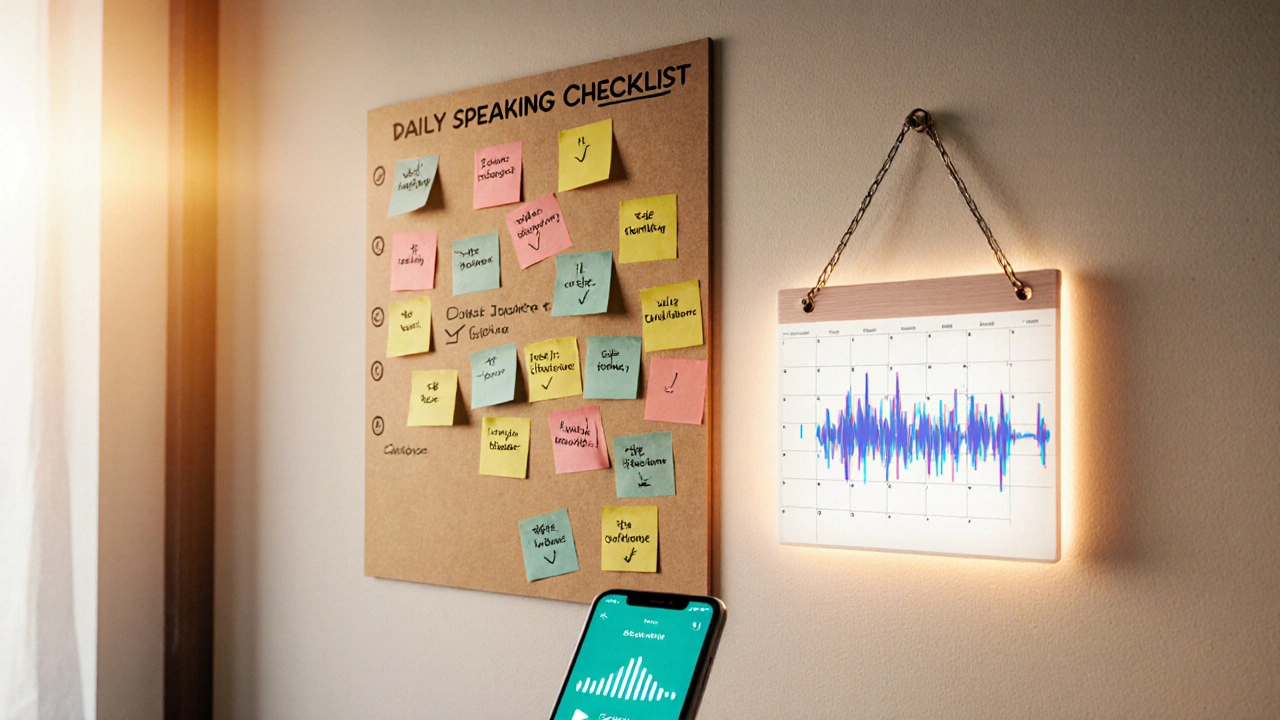Daily Speaking Progress Tracker
Your 30-Day Speaking Sprint
Track your daily practice to see how consistently speaking builds your English fluency.
Your Progress
Today's Score
Key Takeaways
- The single most effective skill for rapid English fluency is active speaking practice.
- Combine speaking with focused pronunciation work and real‑time feedback.
- Use conversation clubs, online speaking platforms, and the shadowing technique daily.
- Track progress with a simple checklist and adjust tools as you improve.
- Avoid the trap of over‑loading vocabulary without speaking it aloud.
Imagine being able to hold a 10‑minute conversation with a native speaker after just a few weeks of focused practice. That transformation isn’t magic; it’s the result of honing the English speaking skill the ability to communicate verbally in English with clarity and confidence. While many learners chase endless word lists or grammar drills, the best skill to learn English is actually the habit of speaking out loud and receiving instant correction.
Why Speaking Beats All Other Skills
Speaking forces you to blend three core language components at once: vocabulary, grammar, and pronunciation. When you try to write a sentence, you can edit and think twice. In a spoken exchange, you must retrieve words, form correct structures, and articulate sounds in real time. This high‑stakes environment builds neural pathways far quicker than isolated study.
Research from the University of Zurich showed that learners who spent just 30 minutes a day on structured speaking practice achieved a B2 level in six months, while peers who focused on reading and listening lagged behind by two proficiency bands.
In short, active speaking is the accelerator that turns passive knowledge into usable fluency.
Core Components of Effective Speaking Practice
- Pronunciation practice focused drills on vowel and consonant sounds - sharpens intelligibility.
- Vocabulary building learning words in context rather than isolation - gives you the material to say.
- Listening comprehension understanding native speech patterns - feeds the feedback loop.
- Speaking confidence mindset and anxiety‑management techniques - lets you stay in the conversation.
- Accent reduction subtle adjustments to sound more natural - enhances clarity.
Each piece supports the others, but the first three become almost automatic once you start talking regularly.
How to Build a Daily Speaking Routine
- Warm‑up with shadowing. Pick a 1‑minute clip from a podcast, repeat every phrase instantly, matching rhythm and intonation. This trains muscle memory.
- Record yourself. Use your phone’s voice memo to answer a prompt (e.g., “Describe your favorite city”). Listen back and mark mispronounced sounds.
- Get live feedback. Join a conversation club a group that meets weekly to practice English or an online platform like iTalki where a tutor corrects you in real time.
- Apply new vocab. After each session, write three sentences using the new words you just used verbally. This reinforces memory.
- Reflect and plan. At the end of the day, note one speaking success and one area to improve. Adjust the next day’s focus accordingly.
Consistency beats intensity. Even a 20‑minute focused session daily yields measurable gains within a month.
Tools & Resources - What Works Best
| Resource | Primary Focus | Typical Cost | Best For |
|---|---|---|---|
| iTalki | Live tutor feedback | $15-$30 per hour | Personalized correction |
| Toastmasters International | Public speaking practice | Club dues $20-$40 | Confidence & leadership |
| Speechling | Shadowing & pronunciation | Free tier, $15/month premium | Accent reduction |
| Discord Language Exchange | Peer conversation | Free | Casual practice & cultural tips |
| IELTS Speaking Sample Tests | Exam‑style prompts | Free PDFs | Test preparation |
Pick at least one live‑feedback tool (iTalki or a local conversation club) and pair it with a free shadowing app like Speechling. The mix ensures you get corrective input while building natural rhythm.

Checklist - Your 30‑Day Speaking Sprint
- ☑ Choose a daily 20‑minute slot for shadowing.
- ☑ Sign up for a weekly conversation club or schedule two iTalki lessons.
- ☑ Create a simple spreadsheet: Date, Prompt, New Vocabulary, Pronunciation Issue, Confidence Rating.
- ☑ Record at least one 2‑minute monologue per day.
- ☑ Review recordings every Sunday and note recurring errors.
Stick to this checklist for a month, then reassess. Most learners report moving from “basic phrases only” to “able to discuss work projects” within 30 days.
Common Pitfalls and How to Dodge Them
- Over‑loading vocabulary. Learning 50 new words a day without speaking them leads to rapid forget‑forget. Pair each word with a spoken sentence.
- Fear of mistakes. Mistakes are data points. Record them, fix them, move on.
- Relying solely on apps. Apps are great for drills but lack the interactive nuance of a human listener.
- Skipping feedback. Self‑assessment is useful, but an external ear catches blind spots you miss.
Next Steps - Keep the Momentum Going
After your initial sprint, raise the bar: aim for 30‑minute sessions, tackle higher‑level topics (politics, technology), and graduate to giving short presentations in your conversation club. The skill you’re honing-active English speaking-has a compounding effect. The more you use it, the easier it becomes to absorb new grammar and vocab automatically.
Can I become fluent without a tutor?
Yes, self‑study works if you enforce daily speaking, use shadowing, and get occasional feedback from language‑exchange partners. A tutor speeds up correction, but disciplined practice can achieve similar results over a longer period.

How much time should I dedicate to speaking each day?
Aim for at least 20 minutes of focused speaking. Consistency beats occasional marathon sessions. Split the time: 5 minutes shadowing, 10 minutes conversation, 5 minutes self‑recording.
What’s the best free resource for pronunciation?
Speechling’s free tier offers daily pronunciation drills recorded by native speakers, plus instant playback for comparison.
Should I focus on British or American English first?
Choose the accent you’ll encounter most often-whether through work, study, or media. The core speaking skill transfers; you can later fine‑tune accent specifics.
How do I measure my speaking progress?
Use a simple scorecard: rate fluency, pronunciation, and confidence on a 1‑5 scale after each session. Over weeks, you’ll see scores rise, confirming improvement.
